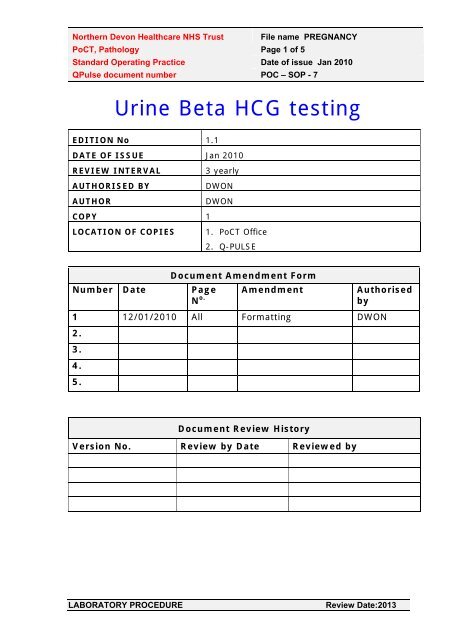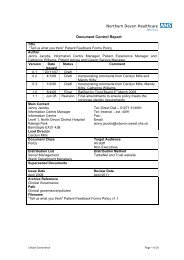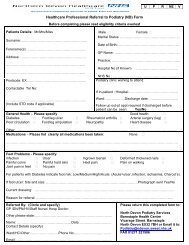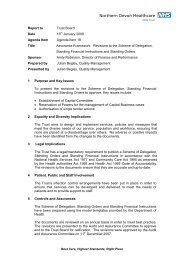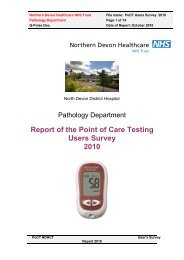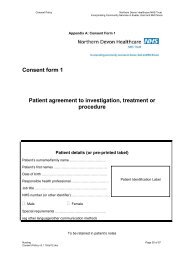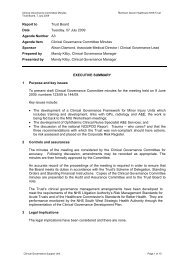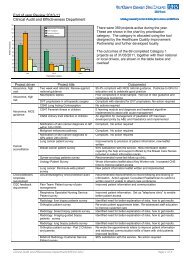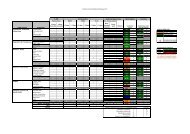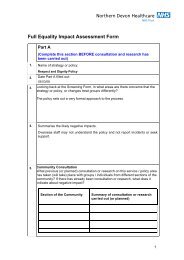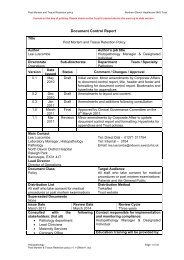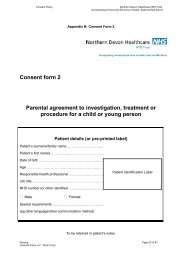Pregnancy Testing â Standard Operating Procedure
Pregnancy Testing â Standard Operating Procedure
Pregnancy Testing â Standard Operating Procedure
You also want an ePaper? Increase the reach of your titles
YUMPU automatically turns print PDFs into web optimized ePapers that Google loves.
Northern Devon Healthcare NHS Trust File name PREGNANCYPoCT, Pathology Page 3 of 5<strong>Standard</strong> <strong>Operating</strong> Practice Date of issue Jan 2010QPulse document number POC – SOP - 71 SCOPE AND PURPOSEDiagnosis of pregnancy, missed abortion, threatened abortion and ectopicpregnancy.2 RESPONSIBILITYThe head of department has overall responsibility for the performance of thisassay.Routine running, staffing and Quality Assurance are the responsibility of a seniormember of staff under the direction of the head of department.Review and updating of the <strong>Standard</strong> <strong>Operating</strong> procedure is the responsibilityof the Point of Care <strong>Testing</strong> Manager with reference to current documentation.3 REFERENCES1. Danielian P.J et alia. (1994) A protocol for the management of early ectopicpregnancy using a rapid 1 hour quantitative serum β-hCG assay. J ObstetGynecol. 14, 99-102.2. Cole L A. et alia. (1994) Detecting and monitoring trophoblastic disease. JReprod Med. 39. 193-200.3. see references on pack insert.4 DEFINITIONSβ-HCG Beta Human Chorionic Gonadatropin, the hormone measured as an indicatorof pregnancy.PoCT Point of care <strong>Testing</strong>, pathology investigations performed outside thelaboratory setting.QCQuality Control, materials or processes used to check to check systemperformance.EQA External Quality Assurance, materials/processes used to check systemperformance that are supplied by an external source.5 RELATED DOCUMENTSMedical Devices Policy.Infection Control Policy.One Step hCG <strong>Pregnancy</strong> Urine Test AC-FHC-U102 instruction leaflet (attached)LABORATORY PROCEDUREReview Date:2013
Northern Devon Healthcare NHS Trust File name PREGNANCYPoCT, Pathology Page 5 of 5<strong>Standard</strong> <strong>Operating</strong> Practice Date of issue Jan 2010QPulse document number POC – SOP - 7i. Reference RangesSee below.j. Guide to interpretationIn early pregnancy, hCG will double in concentration in approximately 24h. Thusin normal pregnancies hCG will reach 20 iu/L in 4-5 days (visible as a weakpositive). However the detection of hCG at this level does not necessarilyindicate a viable pregnancy, because as many as 33% of implantationsspontaneously abort.An ectopic pregnancy will show a much slower rise or even plateau with hCGvalues lower than for a comparable stage of normal pregnancy. A fall inconcentration will suggest a failing pregnancy or miscarriage. The time postmiscarriage before the levels become undetectable will depend on the peak levelof hCG reached.Raised levels of hCG are also present in other conditions e.g. hydatidiformmoles/choriocarcinoma.Current practice has brought about the requesting of quantitative serum hCG.These are currently available on request from Biochemistry but are onlyroutinely available for ectopic pregnancy screening (when abdominal ultrasoundscans are negative) with two serum samples 48h apart. The assay of asample urgently is generally not indicated but can be provided after discussionwith Biochemistry.7 HEALTH AND SAFETY/COSHHSome components may contain human source material and/or other potentiallyhazardous ingredients that necessitate certain precautions:Handle all components and all patient samples as recommended for anypotentially infectious human serum or blood specimen in the HHS PublicationNo. (CDC) 93-8395, Biosafety in Microbiological and Biomedical Laboratories,U.S. Government Printing Office; Washington, DC, 1993, pages 16–18. FollowUniversal Precautions when handling patient specimens as detailed by theInfection Control Manual.Use disposable gloves. Wipe up spills promptly and decontaminate affectedsurfaces. Avoid generation of aerosols. Follow appropriate waste handlingregulations applicable to your area (see Safety Code of Practice section 22).See COSHH sheets for details of individual reagents:http://www.chm.bris.ac.uk/safety/msds.htmhttp://www.chm.bris.ac.uk/safety/coshh.htmhttp://physchem.ox.ac.uk/MSDS/LABORATORY PROCEDUREReview Date:2013


